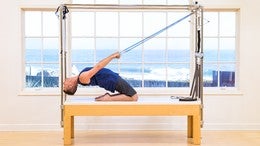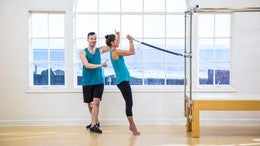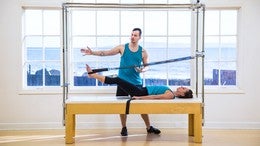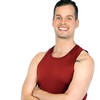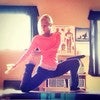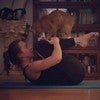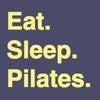Description
About This Video
Transcript
Read Full Transcript
Hi, I'm Benjamin and I'm here with Mary and we're going to take a look at the push through bar and the various ways that we use it in the original work. Uh, we're working on a balanced body Cadillac with a heavy spring and rots spring, I believe. And we're going to start with the push through exercise, which is what gave this bar its name. One of the things I find interesting when working with it is that unlike most pieces of apparatus that we work with employees, there's a very predictable trajectory forward and back up and down. Whereas on this one we have a semicircular motion. That for the body means that we have to dynamically adjust on how we receive the load. And at the same time, the spring tension is usually both supportive and restrictive within the same exercise. So we're going to take a look at the push through first for that, she's going to have her legs against the Poles, her hands on the bar at about shoulder distance. And the way I like to teach push through is to first get really clear on the type of energy you want to put into the bar and into your body, how to position yourself as well as the sensation you're after.
Go ahead and extend your arms up and forward and try to get the bars close to the top of the Cadillac Tower as you possibly can. At this point, your knees can be slightly soft to really allow the back to be fully extended and to allow for Nice fold at the hip creases as well. Let's refer to this as position number one for push through. The second one is Mary's going to roll herself back as if she wants to lie down on her back, curling back until the bar holds her in place. At that place where you get stuck, I want you to pull with both arms on the bar as if you're trying to yank it out of the Cadillac. And at the same time you push your feet into the Poles as if you were to lift your seed by a millimeter off the mat. And with that, you start to probably feel your lower back opening a little bit.
Let's call that position to go back to one, lift the bar up and come forward. Allow your knees to soften and go into this full on extension. So we're alternating the movement of our spine from flection into extension, forward rounded back bend. Feels quite yummy. We'll go back to position two. As he's pulling on the bar, she's rolling down. She allows herself to get stuck. This is where the bar wants to go up and forward, but our trajectory is to go down and forward.
So our next step after she's found her energy here, she's keeping the shape in her spine and she treats her arms like an extension of her spine. She rounds forward like a spine stretch on the mat, taking the bar with her, and because the bar is still pulling in the opposite direction, it helps the body not hinge into the hips as much as keeping some space between the thighs and the abdominals. Creating a nice round in the back and creating the spine stretch or horseback shape. From here, follow the bar to curl yourself back and try to catch the bar. Position two, which is the hard part because here as the semicircle of the push through our changes, the bar just wants to whip up and forward. You find your control there and then here's the, you let it go and you come back to position one. So that is a breakdown and that's of course not the exercise.
We want to flow from one position to the next. So go ahead and roll yourself back. Energize the legs, pull the bar down and push it forward. Tilting your spine over your hips, rounding your spine, head to tail. Curl yourself back. Control the bar when it wants to fling up. Keep pressing down into it from your center and lift back up. And let's take one more here. Rolling yourself back. Push the bar down, tilt over your legs. Find that stretch. Feel how the bar comes into wards.
You roll yourself back one more time and they're lifted all the way up. And that is your basic push through exercise here. Now, a lot of you might find that in that position to where the bar wants to fling up in front of you, you have not enough power to move the heavy spring. If you work with a heavy spring ride, you can let go for a second, so a trick you can use to lessen the resistance on the spring unless you have an optional alternative spring, is to grab an extra carabiner and attach it so that the spring extends. It'll take some of the tension out of the spring. We're not going to demonstrate that, but know that that is an option.
We're going into a reverse push through next. Our second way of relating ourselves to the push through bar. Again, the bar moves in somewhat more unpredictable ways because it travels along the semicircle. She's already set herself up perfectly. You want the bar not in between the Poles but slightly away from them. You're with straight arms, straight spine and straight legs and you want to think of your rowing on the reformer a little bit here. It's not so much about displacing the torso back and forth and loading into the shoulders as much as it is about letting the spine travel on its own.
So just like our push through thing of curling both ends of your spine towards one another, coming into a half roll back of sorts so that the shoulder girdle is now being stretched by the bar by that position of her arms. This shape remains as she tilted forward similar to a push through from early and then with control, she allows the bar to lift her up, which is very reminiscent of what we experienced in rowing on the reformer. The back ribs puff up to lift the arms up, head travels to the knees, she sends her center back, letting the bar carry her arms away from her. I want to make sure that your elbows are nice and supported here because it can be an intense toward occurring at the wrist and at the elbow because your hands are locked in space, which is why we do two different variations of this exercise. Go ahead and come back and just upright your spine from here.
I'll hold the bar down for you to change your hands to an underhand grip. Exactly. So you'll just switch the position of your hands. Those are really the only two options we have here and I always recommend doing both. You might prefer one over the other, and if this ever bothers you at the elbow, make sure that you really grab onto the bars of the muscular turn. Your arms is nice and engaged. We're just going to do one more round here. So lift up and out of the ways. Roll yourself back.
Notice the difference in sensation because now you have a different rotation at the top of the shoulder. Carry the spinal shape forward. Puff up the ribs to let the bar lift your arms up. Gorgeous. One more time. The bar has to come towards the body. Now it moves away again. So it is your responsibility as you come forward again to take it far enough so that the ar can complete its semicircle from here and hopefully this feels like a lovely stretch. Go ahead and come back up, right your spine from here and we're going to let that bar go. I have it. All right, just yes, swing around so I can release it.
Next up we're going into an exercise series that we do lying down underneath the bar. It's a roll of which we can take into a teaser and all kinds of other fun things. Now positioning here is so that we want our chest to be kind of underneath this bar, so come further down than you think and then grab the bar right here. Found a perfect spot. The first part here, using the framework of the Cadillac also make sure that your body is centered, is to just get the bar down, elbows wide to the side and getting the elbows to touch the table or the Cadillac. Rather. Once you have your arms here, go ahead and hold the bar for a second. See to it that your ribs still deep and down in opposition so it should feel like a massive opening of the chest against that. Push your arms over your head back behind you.
Still finding that connection into the back of your body. Bring the bar back. It travels along the semicircle. This is where you have to control it because the spring just wants to close. That's the only thing it knows to do. Let's do that one more time. You pull the bar down, rip. Say steady. They can move, but you want to find opposition through them.
Bar goes back and we'll now take it into a roll-up. So think of it like a teaser, but the legs stay down. The bar assists you on the first bit of it. As she brings her chin over our chest and rolls up. The spring wants to close so it lifts her up.
But once the semicircle of the push through our takes it back behind her and actually holds her responsible to keep her spine lifted on her own terms, go ahead and roll yourself back and down. Pull the bar towards you and then press it over your head and we'll do one more round like that. The elbows wide now to the side, arms extend up. She rolls herself up, the bar supports her and now it actually makes it harder for her to maintain that connection. I want you to feel as though I could take that bar away from you and you could stay exactly where you are. Go ahead and roll yourself all the way down. We'll take one more round like that. Pull the bar towards you, push it overhead, return back in, arms go up.
Now another image I want you to find here is imagine there's somebody, maybe me standing on this bar, so as you lift yourself up, not only does the spring support you imagine that you're pushing up against weights so that your arms can really connect into your back. It'll help you with everything that's to come even here at the top. Imagine a way pressing down on you so that your ribs don't lock forward from here. Go ahead and roll yourself all the way back down. Taking the semicircle of the push throughout, all the way back behind and then take the bar in and we'll add a teaser. Arms, go up, Chin over, chest, lift yourself all the way up to the top.
The legs float out of the body. This time, same rules apply. Take a deep breath in. Find the opposition between the legs reaching in your ribs, deepening and go ahead and the roll yourself back down. Pull the bar towards you. She's doing an awesome job doing that. Nice and slow for us today. Let's do it a little faster. Flow right through.
Let the bar really give you the momentum. You need to find your teaser at the top and then take it all the way back down. Pull the bar towards you, push it back behind you. I'll hold the bar so you can let go of it and then you can turn yourself over to your stomach. Last way we use the portion of our today is for our Swan, right? So you want to have the bar about in between the Poles, if not right in between, somewhat closer towards you.
Rather than pushing it beyond, you want to be an arm length away from the bar. Your head is down right at the hairline or forehead so that you have the back of your neck. Lengthen out from here and make sure that your low back is nice and long on the mat as well. I always like to think of the hip bones pressing straight down into the mat as well and then just make sure that you can breathe in this position that you don't feel constricted through your neck or shoulders because the push bar is a little higher up than the mat. In this position you might find that you have a really hard time doing this because your shoulders are not open enough, which means that this is probably not a good exercise for you to choose, but you could always start with your head somewhat lifted and just work on creating that openness to the front of the arm. How are you feeling there? Good.
First thing, just like we did on our back, we're taking the bar sort of down towards the head, bending the elbows out to the side and just like earlier you will find a place where you get stuck where you feel like you can go any farther. At that point, I want you to just take a nice deep breath in, see if you can wing your elbows out to the side a little bit to almost get a passive stretch and opening across the front of the arm into the collarbones. Go ahead and push the bar back out in front of you and let's do that one more time. So it's like our shaving action and the rowing series on the reformer. Beautiful. It can result in a little bit of a lift. Allow it to happen, allow it to open up your chest and then push the ball away from you guys. We'll do just that one more time and add on going into a half lift because the bar really wants to pull up against her.
She has to oppose it by widening the arms. Now stay up and push the ball out in front of you. Lift yourself away from your arms so your arms push forward, your chest lifts up, and without pulling the bar too far towards you, see what height you can find into a little supported back. Then take a nice deep breath. Feel how the bar is really still coming for you because that spring is, and then with straight arms, just go ahead and push the ball away from you.
So we'll start one more time with that little arm. Ben, bring the bar behind the head, push it away from you while lifting your chest up. So find that opposition arms extending forward. Lifting yourself up as an example. You could very easily kind of cheat here with the bar and let the bar whip you up into a really high back then. But I want you actually push it away from you this entire time and let your sternum travel forward instead, go ahead and come all the way down.
I want to take the full swan next and last. Go ahead and bend your arms maximum amount that you got now. Think your arms continue to travel up to the ceiling and your head follows the bar from pulling on the bar. Your effort changes into pushing against it, containing the front of the ribs, extending the legs back, lifting your gaze towards the bar or beyond it, and then come back down the same way you went up, you length and forward through your spine. The bar follows you. You find that openness across your chest. Again, you're pushed the ball away from you. Again, using the semicircular motion of the push through by, let's do one more bend the art's stretching up, push forward into the bars. The bar continues its trajectory. Push against it to find that connection in the front of your body. Beautiful.
And then take it all the way back down. Push the bar away from you. Here's the desserts. Hold onto that bar nice and tight. Allow your hips to stretch and then go ahead and let go of the by habit. You can sit back over your heels for little counter stretch and then one more time. I'm going to take that bar along. It's semicircle to let it all the way release.
So these are some of the basic exercise that we do with the push through bar in four different ways. How we can relate our body to the semicircular trajectory of the push through our.
Comments
I have a question regarding leg positioning during the Swan. I have been taught to open and turn out the legs, in order to get maximum range of movement through the hips. Meredith works with legs parallel and adducted in this video. What are your thoughts on the one position versus the other?
You need to be a subscriber to post a comment.
Please Log In or Create an Account to start your free trial.
